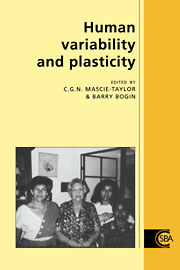Book contents
- Frontmatter
- Contents
- List of contributors
- Foreword
- 1 The pervasiveness of plasticity
- 2 Plasticity in early development
- 3 Plasticity in the growth of Mayan refugee children living in the United States
- 4 The place of plasticity in the study of the secular trend for male stature: an analysis of Danish biological population history
- 5 Plasticity, growth and energy balance
- 6 The study of migrants as a strategy for understanding human biological plasticity
- 7 Human migration: effects on people, effects on populations
- 8 The use of surnames in the study of human variation and plasticity
- 9 A biological anthropological approach to measuring societal stress of parasitic disease: a case study of schistosomiasis
- 10 Biological adaptability, plasticity and disease: patterns in modernizing societies
- 11 Human biological adaptability with special emphasis on plasticity: history, development and problems for future research
- Index
11 - Human biological adaptability with special emphasis on plasticity: history, development and problems for future research
Published online by Cambridge University Press: 28 October 2009
- Frontmatter
- Contents
- List of contributors
- Foreword
- 1 The pervasiveness of plasticity
- 2 Plasticity in early development
- 3 Plasticity in the growth of Mayan refugee children living in the United States
- 4 The place of plasticity in the study of the secular trend for male stature: an analysis of Danish biological population history
- 5 Plasticity, growth and energy balance
- 6 The study of migrants as a strategy for understanding human biological plasticity
- 7 Human migration: effects on people, effects on populations
- 8 The use of surnames in the study of human variation and plasticity
- 9 A biological anthropological approach to measuring societal stress of parasitic disease: a case study of schistosomiasis
- 10 Biological adaptability, plasticity and disease: patterns in modernizing societies
- 11 Human biological adaptability with special emphasis on plasticity: history, development and problems for future research
- Index
Summary
Summary
The human adaptability paradigm underlies much of the research in human biology conducted over the last thirty years, although explicit application of the paradigm in research has been very rare. Barriers to its use include unstandardized terminology to describe and analyse adaptation, reduced funding for research in adaptability, and the small number of human biologists working in any single area of adaptability. The most serious impediment, however, is lack of agreement among scientists as to how non-genetic adaptation should be measured. Two approaches exist: evaluate physiological and growth variations in terms of their effect on survival and reproduction, as though they are genetic adaptations; or evaluate non-genetic adaptations in terms of their benefit in restoring homeostasis and achieving well-being. The two approaches may be seen as providing two types of proof, with the genetic standard being more difficult to attain.
Special complexities surround the interpretation of plasticity, or adaptation through growth and development. Two models exist to interpret growth: the adaptability model, in which growth is a means of adaptation resulting in plastic (ontogenetic) adaptations; and the medical model, in which growth is a measure of adaptation. This essay shows how the two models conflict, and notes that the conflict between them cannot be resolved with existing knowledge in human biology. Instead, each model may be limited to a particular area of human biology research. Future research in adaptability may resolve this conflict and develop methods for the replicable measurement of all forms of non-genetic adaptations.
Introduction
In 1969 Gabriel Lasker published an exceptionally articulate review paper. This paper identified three modes of human adaptation; natural selection of genotypes, plasticity (ontogenetic modification), and individual acclimatization.
- Type
- Chapter
- Information
- Human Variability and Plasticity , pp. 213 - 238Publisher: Cambridge University PressPrint publication year: 1995
- 7
- Cited by



